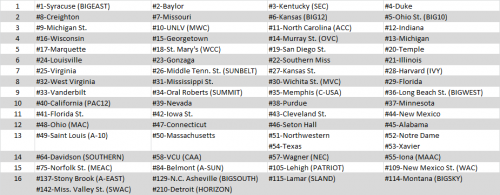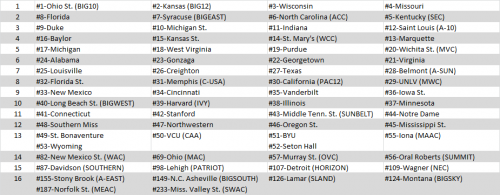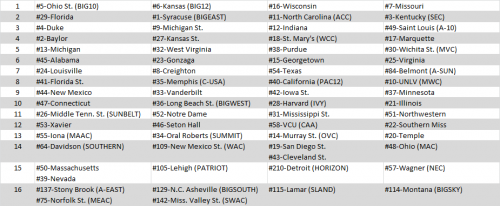Those following along (those that have not, start here, here, and here) know that the goal of the Achievement S-Curve is to reward teams for what they have accomplished on the court. Wins and losses count. Strength of schedule counts. Scoring margin, the eye test, true team strength…they don’t count.
There are good arguments against simply selecting and seeding teams based on who is the most deserving as opposed to just the best teams. For one, some people simply prefer to select the best teams and see them go at it in the tournament. Secondly, while seeding teams based on achievement rewards the top teams with good seeds and likely easier paths in the tournament, you may sometimes inadvertently hurt some of these teams who draw teams that underachieved during the season. Take Washington as an example from last season–they were a top 10 team by some rankings of the best teams but underachieved and drew a 7-seed. A team that earned a 2-seed would actually be better off as a 3-seed drawing an easier 6-seed as opposed to being slotted across from the Huskies.
So, this week, I offer two alternative S-Curve systems:
- A “True Strength” S-Curve, that selects the best 37 at-large teams in addition to the best team in each conference and seeds them according to their estimated “true” team strength.
- A “Combo” S-Curve, that selects teams the same way as the Achievement S-Curve, but then seeds them based on True Strength. So you get INTO the tournament based on your overall profile, but once you’re in teams are seeded by how good they actually are.
First, the normal Achievement S-Curve. As always, you can find the full rankings at Google Docs here.
Next, here’s what the tournament looks like if you simply select the best teams. The number next to each team in this chart is their true strength rank among all teams.
And finally, let’s combine the two. Here is the Combo S-Curve. The number next to each team here is their Achievement S-Curve rank so you can see which teams moved up and down the most:
Florida (up to a 2-seed), Saint Louis (up to a 3), and Belmont (up to a 7) are three teams that greatly benefit from switching to the true strength system. Baylor (down from the top line to a 4-seed), Murray St. (down to a 13), and San Diego St. (in a play-in game as a 14) take big falls as all have overachieved thus far.
The point here is that while I may prefer my system, there are other reasonable ways to seed the tournament and a system can be created to fit whatever criteria you prefer. I know the Gators disagree with me and would be happy with a change to the Achievement S-Curve.




ce99cx